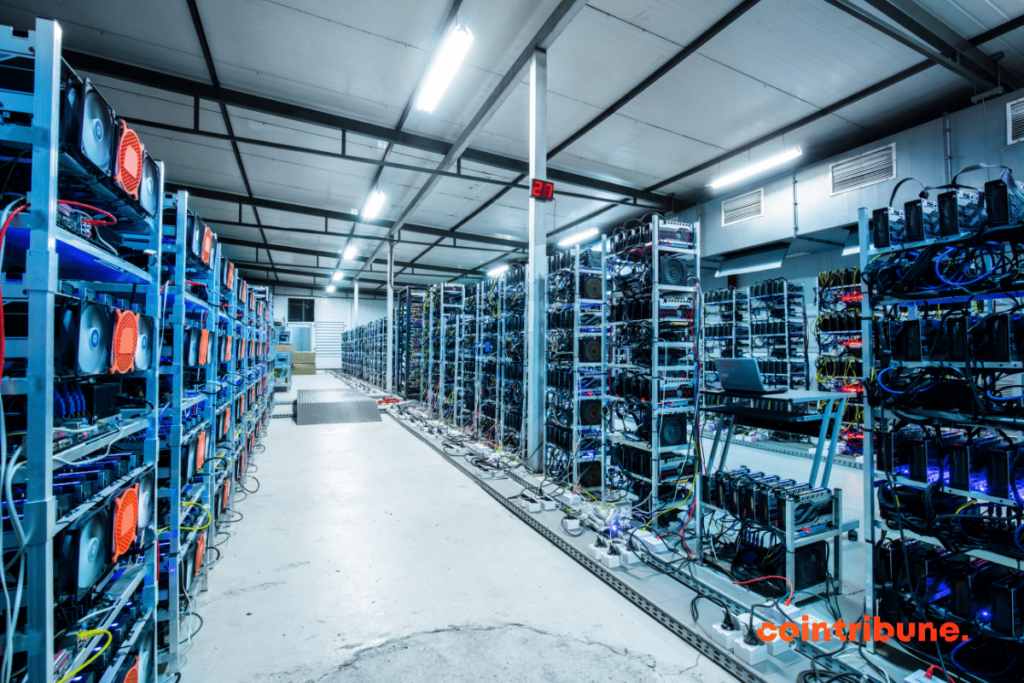Staking vs. Mining: Comparison and Advice
In the world of cryptocurrencies, staking and mining are two key strategies for increasing one’s digital assets. While mining relies on computational power to secure the network and validate transactions, staking involves holding funds in a cryptocurrency to support the integrity of the network. This article compares these two methods in detail, exploring their techniques, profitability, and associated risks. Whether you’re a seasoned investor or a newcomer to the crypto industry, understanding the nuances between staking and mining will allow you to optimize your investments and navigate the crypto ecosystem with confidence.

Staking and Mining: Clarification of Concepts
In the cryptocurrency universe, two predominant methods exist for earning rewards: staking and mining. Mining is a process by which cryptocurrency transactions are verified and added to the blockchain, using Proof-of-Work (PoW). Miners use powerful computing equipment to solve complex cryptographic puzzles and, in return, receive tokens.
Staking, on the other hand, is a less energy-intensive practice that involves holding tokens in a cryptocurrency wallet to support the operations of a blockchain network using Proof-of-Stake (PoS). Participants or stakers lock their tokens to become eligible to validate transactions and create new blocks. In return, they receive rewards in the form of additional tokens.
Technical Comparison of the Two Methods
Staking and mining are two popular methods in the crypto world, each with its own technical specifics. While mining relies on Proof-of-Work, staking is based on Proof-of-Stake. These methods fundamentally differ in their approach to transaction validation and block creation on a blockchain.
Mining is the historical pillar upon which the security of networks like Bitcoin relies. Miners use specialized equipment to solve complex cryptographic problems that secure the network and validate transactions. This process is energy-intensive and requires considerable computing power, which has direct implications on energy consumption and the environment. Miners are rewarded for their work, but mining difficulty adjusts based on the total network power, which can influence profitability.
Staking, on the other hand, requires users to stake their cryptos in a wallet to participate in transaction validation. In PoS networks, validators are algorithmically chosen, often based on the amount of currency they hold at stake. This reduces energy consumption since the process does not require intensive computing power. Additionally, staking allows for greater predictability of rewards, although they may vary depending on the specific rules of each blockchain.

Advantages and Disadvantages of Both Methods
The choice between staking and mining is crucial for cryptocurrency investors looking to maximize their gains while minimizing risks. Each method has its own advantages and disadvantages that can influence an investor’s decision based on their goals, risk tolerance, and available resources.
Advantages of Mining
Mining is one of the earliest methods adopted to acquire cryptocurrencies like Bitcoin. It allows miners to directly contribute to the robustness and security of the blockchain network. By solving complex mathematical problems, miners help validate transactions and create new blocks, which is important for the maintenance and development of the network. The rewards obtained through mining are often substantial, especially when the value of mined cryptos increases in the market, offering high profit potential.
Additionally, mining offers some predictability of rewards based on the contributed computing power and electricity cost. Miners can calculate their potential earnings by analyzing these variables, allowing them to plan and adjust their mining hardware investments. Moreover, mining can be a source of passive income if the infrastructure is already in place and market conditions are favorable.
Advantages of Staking
Staking is often seen as a more environmentally friendly alternative to mining. It requires fewer hardware resources and consumes significantly less energy since there is no need for intensive computing hardware. This makes staking particularly attractive to those who are conscious of the environmental impact of blockchain technology and who seek to participate in the cryptocurrency ecosystem in a more sustainable way.
Another advantage of staking is its accessibility. Users can start with a relatively small amount of cryptos and increase their stake over time. Additionally, staking offers predictable rewards based on the percentage of cryptos held, which can provide a stable and predictable income stream, especially on platforms offering high reward rates.
Disadvantages of Mining
Despite its advantages, mining faces major challenges. Rapid equipment obsolescence and increasing market saturation can reduce earning opportunities. The growing centralization of mining also raises questions of network security and control, as large mining farms can have disproportionate influence over the blockchain.
Disadvantages of Staking
For staking, the main disadvantage is that cryptos must be locked up to participate in the process, reducing liquidity and exposing the investor to losses if the crypto price drops. Additionally, the success of staking depends heavily on the governance and economic design of the relevant blockchain, which can introduce an element of uncertainty.
Choosing Between Staking and Mining: Criteria to Consider
Staking and mining have their own requirements and implications. To make an informed choice between these two methods, it is important to consider a series of criteria that will influence the effectiveness and profitability of the investment.
Investor Profile
The investor’s profile is crucial in the choice between staking and mining. Staking is generally more accessible to those new to cryptocurrencies. It requires less technical knowledge and offers a simpler approach to participating in transaction validation on the network. Stakers must be comfortable with the idea of locking their funds for a given period, which can limit liquidity but offers potential regular rewards in return.
Mining, on the other hand, is often aimed at a more technical profile. Miners must be able to set up and maintain specialized equipment. They must also be prepared to constantly monitor the performance of their hardware and adjust their operations based on market fluctuations. Mining requires a larger initial investment and a deep understanding of blockchain mechanisms.
Technical and Financial Considerations
Technical and financial considerations are also paramount. Mining requires a significant initial investment in the purchase of specialized equipment and can entail high operational costs due to energy consumption. Miners must assess potential profitability considering the cost of electricity and the current difficulty of mining for the chosen cryptocurrency.
Staking, although less demanding in terms of equipment, requires an analysis of the different platforms and cryptos available. Investors must consider the expected return on investment, the reward rates offered, and the stability of the chosen cryptocurrency. Staking can offer a more passive path to rewards, but it is important to understand the specific conditions and rules of the platform or network used.
Long-Term Vision and Investment Strategy
Mining can be subject to rapid changes due to evolving technology and regulations, requiring adaptability and strategic vision. Miners must be prepared to reinvest and stay up-to-date with the latest trends to maintain profitability.
For staking, long-term vision involves understanding the growth potential of the chosen cryptocurrency and its network. Stakers must be aware of the risks associated with price volatility and the possibility of changes in consensus protocols that could affect rewards. A well-thought-out investment strategy for staking will take these factors into account and seek to build a diversified portfolio to minimize risks.
Conclusion
Staking and mining offer distinct opportunities in the cryptocurrency domain. The choice between these two methods depends on your financial situation, technical expertise, and investment strategy. While mining is suitable for technical investors willing to make significant initial investments, staking is accessible to beginners and requires fewer resources, while promoting a more sustainable approach. Carefully evaluate each option to align your actions with your financial goals.
Maximize your Cointribune experience with our "Read to Earn" program! For every article you read, earn points and access exclusive rewards. Sign up now and start earning benefits.
The Cointribune editorial team unites its voices to address topics related to cryptocurrencies, investment, the metaverse, and NFTs, while striving to answer your questions as best as possible.
The views, thoughts, and opinions expressed in this article belong solely to the author, and should not be taken as investment advice. Do your own research before taking any investment decisions.